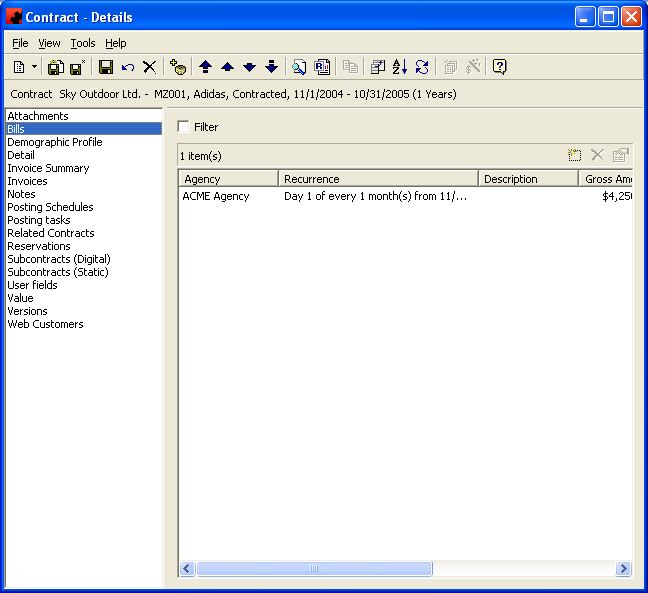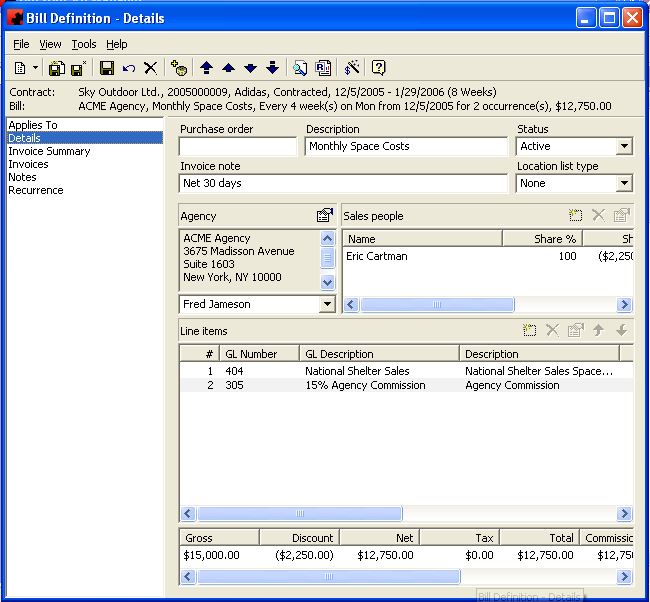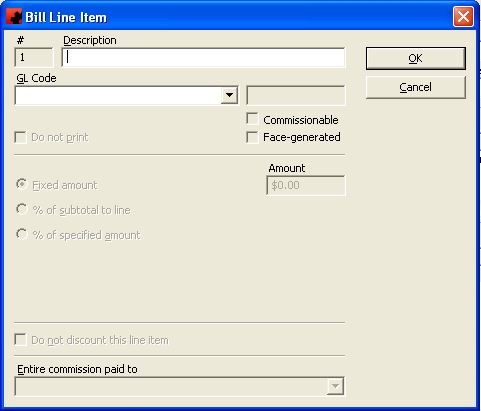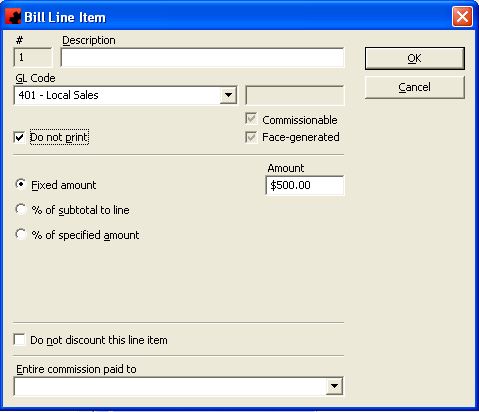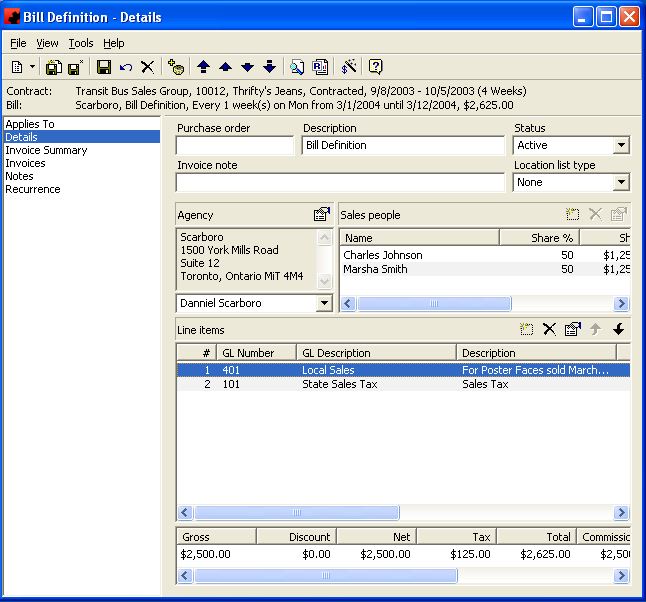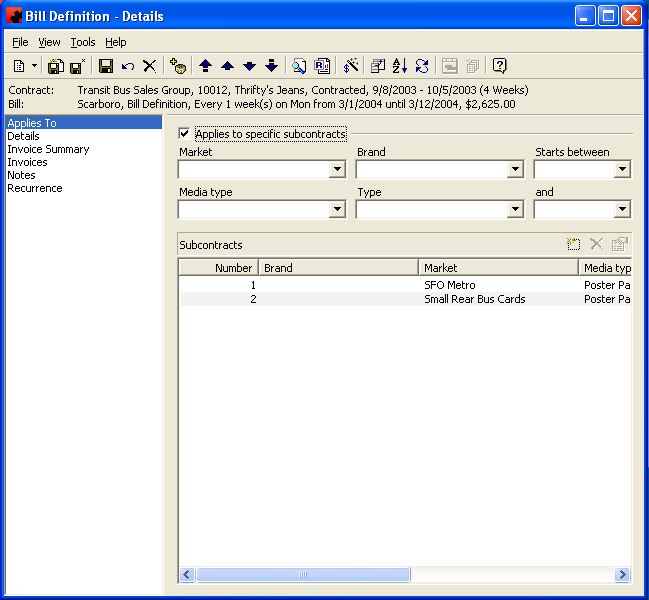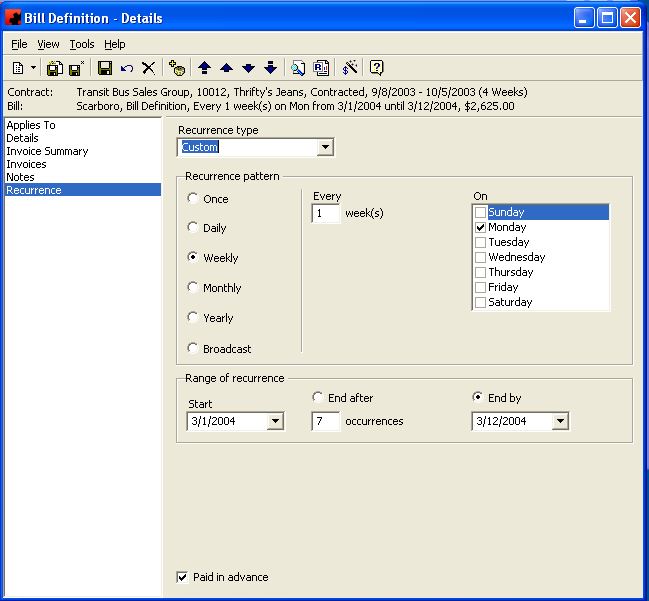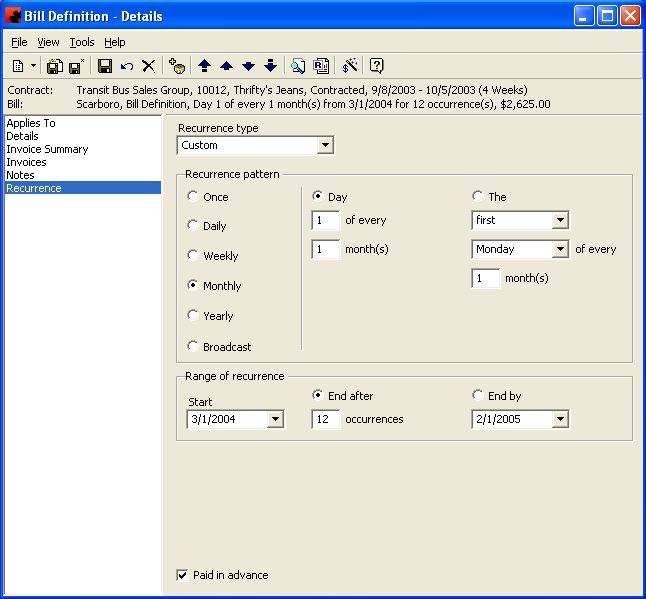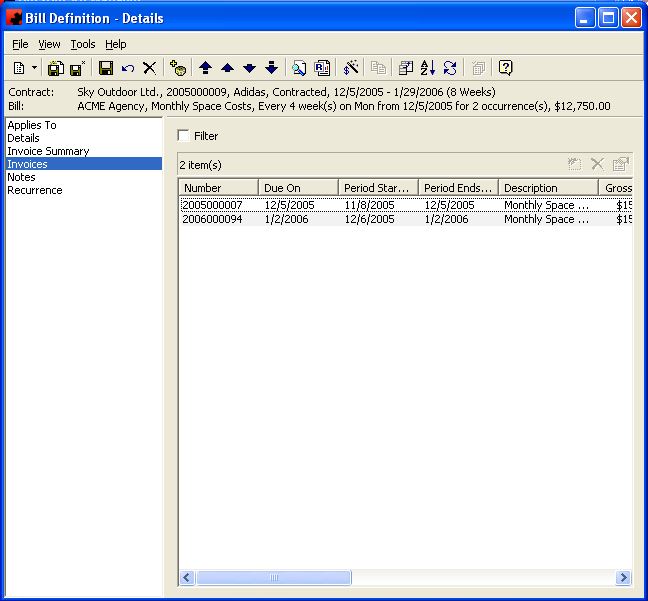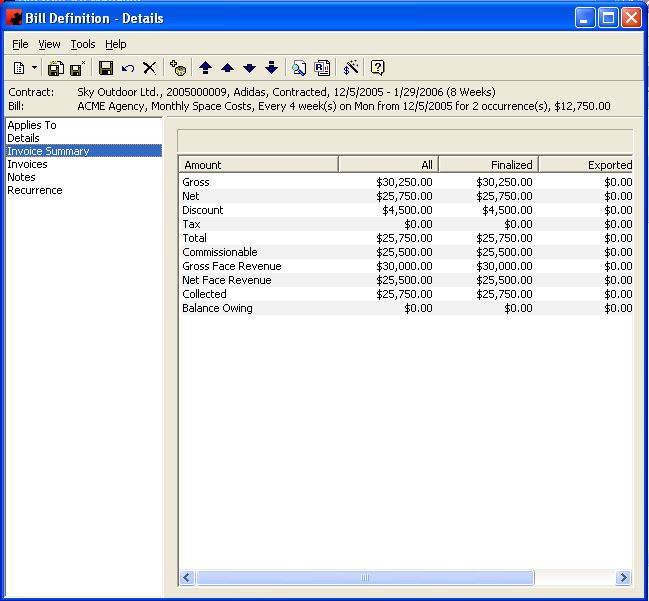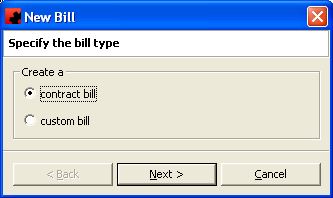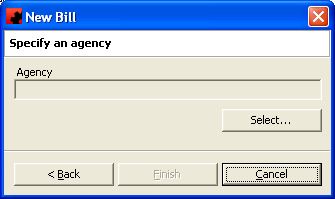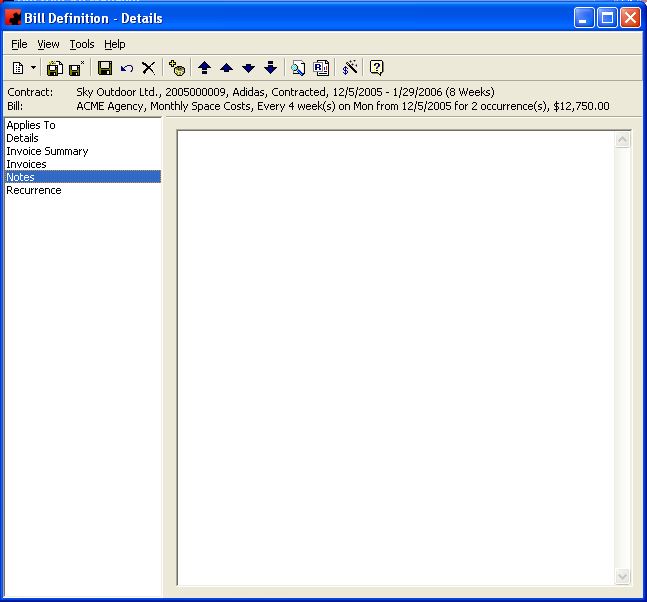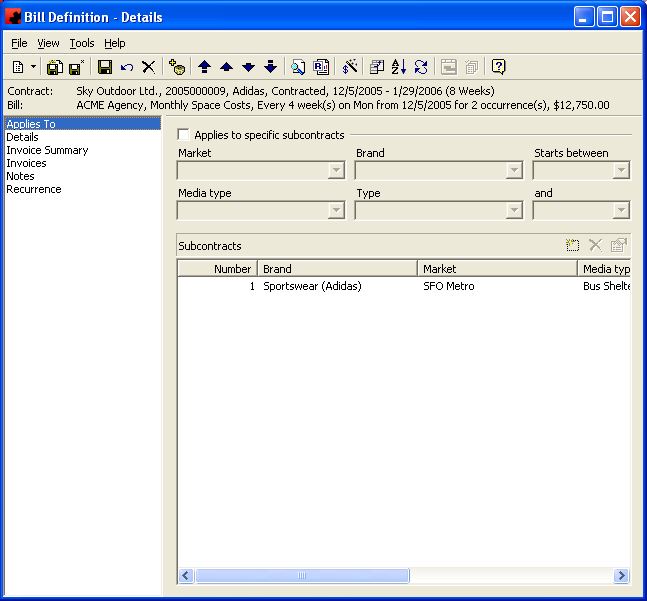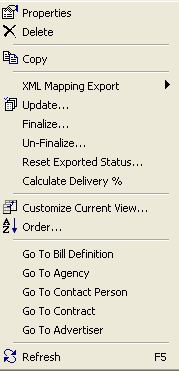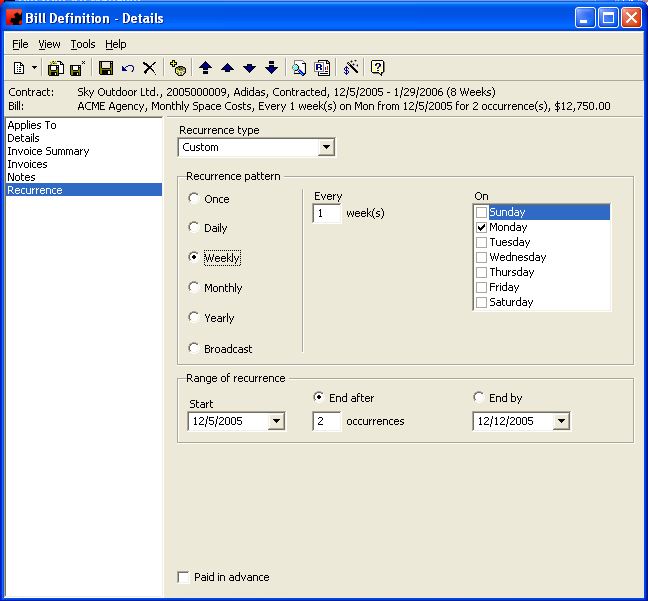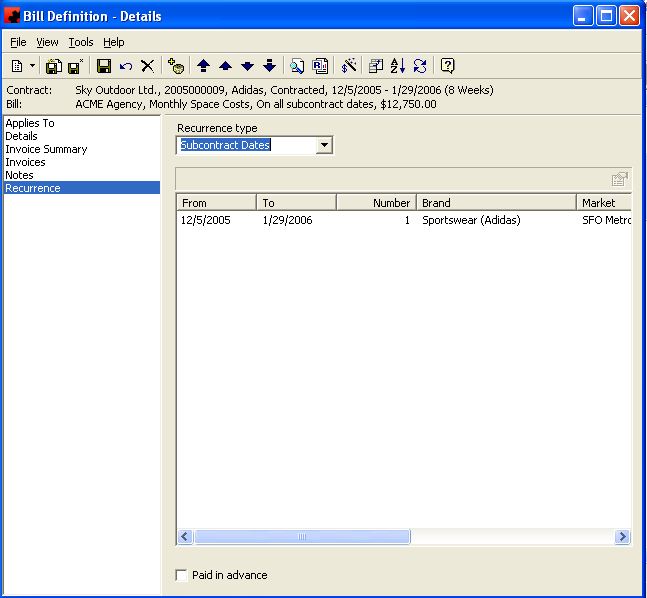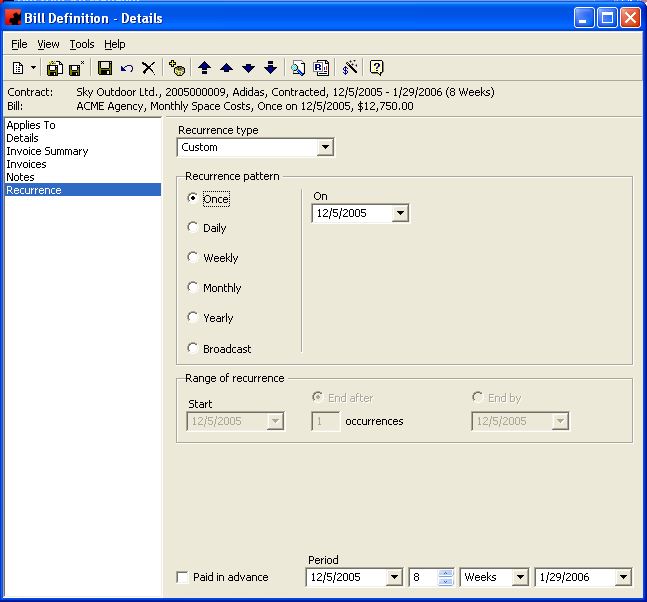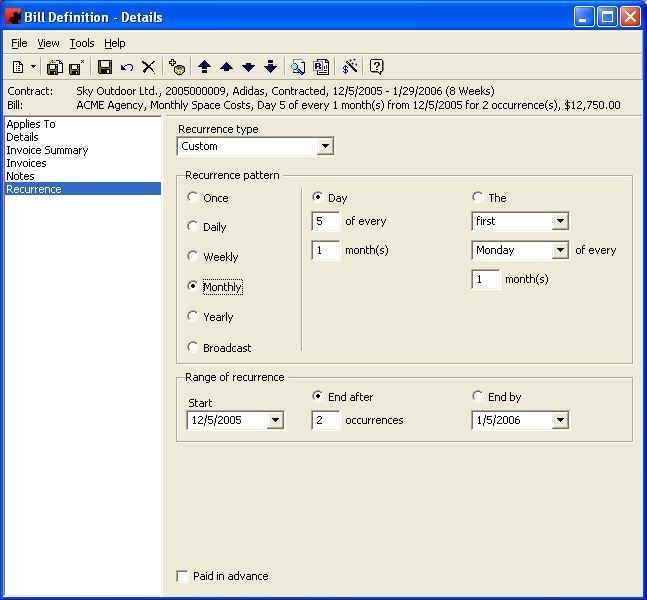Bill definition
Contents |
Adding Bill Definitions
The Bill Definition is used as the "template" for the creation of the Invoices that will be sent to your Advertisers, Agencies, etc. Creating the Bill Definition in Ad Manager eliminates the necessity of duplication of data entry. It becomes a single entry with the pre-determined details being exported to your Accounting package. There are 2 types of Bill Definitions that may be created in Ad Manager - Contract and Custom.
Adding Contract Bill Definitions
This type of Bill Definition is the one that will be attached to a specific Contract and uses some details of it in order to create the "template". It contains invoice amounts for such things as Space, Production, Extensions, etc.
NOTE: Your Contract Bill Definition, even though attached to a Contract, is created independent of the Contract dates and/or amounts. This gives you more flexibility in the creation of your Contracts/Subcontracts/Flights and Invoices.
To create the Bill Definition, find the corresponding Contract using a Finder, Quick Find or a list of Contracts. Click the Bills Page of the Contract and then click the New button to the right.
The first requirement is to select the Agency or "Bill to" for this Bill Definition. Ad Manager will default to the Agency that has been input on the Details page of the Contract. If this is not the Agency who will receive the Invoices created from the Bill Definition, click the Select button and a list of Agencies entered on the Contract Details screen is shown (if more than one). Click <More&ldots;> to obtain a list of all Agencies from the Agency Database. Select one and click Finish. The Bill Definition - Details screen will appear.
This selection will be automatically populated in the Agency Field of your Bill Definition. NOTE: If you accidentally choose the incorrect Agency on the previous screen, you can still correct this on the Bill Definitions-Details screen by clicking the Properties button on that field. The Purchase Order field will populate from the Contract Details Page, as well as the Sales people information, and Contact Person information in the Agency field. If this information is not present, enter it as required. You can identify the percentage of the invoice goes towards calculating each sales person's commissions if there is more than one sales person being attributed to the bill.
The Description field allows you to identify this Bill Definition so it will be easily recognizable from a list of all Bill Definitions. For example, you might enter "Monthly Space Costs", "Credit for late posting", "Bulletin Monthly Cost". The Status determines if the Invoices of this Bill Definition can be exported. Only "Active" and "Force" statuses can be part of an Invoice Export file.
The Invoice Note field allows you to enter an additional line of information that may appear on your Invoices.
NOTE: This note should apply to all Invoices of this Definition. If it does not, enter the note individually on each Invoice once they have been created.
You may also choose to have a location list appear on your Invoice and the format of it by selecting it from the dropdown list. This does not automatically happen, but will need to be programmed to appear in the required field.
To add Line Items for this Bill Definition, click the New button. The following screen will appear.
From this screen you enter a description for the Line item, as well as the corresponding GL Code to which to assign this line item. The GL Code will match an identical Code set up in your Accounting Package. You can specify whether the dollar amount is a fixed amount, a percent of a specified amount, or a percent of the subtotal. Depending on which of these choices you select, different fields of information will appear for you to complete. You can also identify line items that you do not want to print on the invoice, by checking the box "Do not print".
This allows you to set up journal entries that are not part of the printed Invoice, but will be transferred to your accounting package.
NOTE: This will not apply if you are printing your Invoices using Ad Manager Reports.
NOTE: If the Taxes and Discounts criteria have already been established in the GL Code database of Ad Manager, the percentages will automatically appear and the calculation will be done as the Line Items for each are added.
If there is more than one Sales Person on the Contract, you may specify which one will receive the commission for a particular line item at the bottom of the screen. You can also identify if a particular line item is not to be discounted, or when discounts are applied by checking the box "Do not discount this line item". Once you have completed your Line item information, click OK. You can add additional Line items as appropriate.
NOTE: If this Line Item is for an amount that is a credit, it is entered with a minus (-) sign in front.
Ad Manager processes the Line Items in the order they appear in the list of Line Items. If you have a Line Item that is taking a percentage of a subtotal and it is not in the correct spot, Ad Manager will calculate an incorrect amount. To move a Line up or down on the screen, highlight the Line Item and click the move up or move down button as appropriate.
On the Applies To Page you can identify if this Bill Definition applies to a particular subset of Subcontracts. You might use this page if you have a single Contract with Subcontracts set up representing different Media Types or Markets and the invoicing will happen on different dates; or another example might be that you have Bonus Subcontracts set up on your Contract and you don't want to send out an Invoice for these. Click on the box beside the "Applies To specific subcontracts" and then enter the criteria for the particular Subcontracts to which this Bill Definition will apply.
NOTE: The Add and Delete buttons on the screen where the Subcontracts are listed will add or delete the actual Subcontract from the Contract. They are not used to remove a particular Subcontract from the Applies to criteria. What you entered as your criteria will determine your list.
Setting Up Invoice Recurrence
Once you have completed your Bill Definition details, you can identify the Recurrence for this Bill. To do this, click on the Recurrence Page and the following screen will appear.
From this screen you can identify how often and for how long you wish to invoice this Contract. Do this by first selecting a Recurrence Pattern in the top section of the screen. If the Invoices are to be sent quarterly (Jan 1, Apr 1, etc) for example, choose Custom in the Recurrence Type box, and the Recurrence Pattern would be Monthly, Day 1 of every 3 months. If the Invoices are to be sent monthly for example, choose Custom in the Recurrence Type box, and the Recurrence Pattern would be Monthly, Day 1 of every 1 month. You can also choose to invoice on the Subcontract dates if multiple ones have been entered for each posting cycle by selecting it from the Recurrence type dropdown list and Ad Manager will automatically set up the number of Invoices which correspond to these dates and display them on the Invoices Page for you to verify. Also note that you may choose to invoice on a Broadcast calendar by selecting Custom as the Recurrence type and choosing Broadcast.
In the bottom section of the screen set the Range of Recurrence. This identifies the period during which time you wish Invoices to be generated. For example, you might enter the Start Date as August 1, 2005, click the End After and fill in 12 occurrences and the End by date will automatically fill in with the last Invoice date, which, in this example will be July 1, 2006.
You can also identify if the Invoices are "Paid in advance" (i.e. The Invoice is sent at the start of the display period) by leaving the checkmark in the box at the bottom of the screen or sent at the end of the display period by removing the checkmark from the box. To remove the checkmark from the box, click on the box. This field will determine the display Period Dates that are now part of the Invoice information on the Invoices Page. This information can be contained in your Invoice Export and show in printed Invoices. NOTE: If the Invoice Range of Recurrence is set up as Once, you must enter the Period dates to which it applies, regardless of whether the "Paid in advance" box is checked or not.
Once you have entered the Bill Definition Details and the Recurrence, click the Save button. If you wish to review or verify when Invoices are scheduled, go to the Invoices page where a listing of all Invoices created as a result of the Bill Definition will display.
NOTE: No Invoices will appear on the Invoices page until the Bill Definition and its Recurrence have been saved.
Reviewing Your Bill Definition Totals
The Invoice Summary Page summarizes the various dollar values of all Invoices created by the Bill Definition.
It also records the dollar values of finalized, exported and sent Invoices. These amounts will accumulate as invoicing is exported to your accounting package.
Creating Invoices with Escalators
You may find that you will have a Contract on which escalators have been defined over the term of the Contract. For example, you might have a 5-year Contract for a Permanent Bulletin that escalates by 5% every year and you will need to set up the Bill Definitions accordingly. In our example you will have 5 Bill Definitions, each with its own amount, date range, etc. and the Definitions will show the following details:
Year 1: Initial $$ amount
Year 2: Initial $$ amount + 5% = Second $$ amount
Year 3: Second $$ amount + 5% = Third $$ amount
Year 4: Third $$ amount + 5% = Fourth $$ amount
Year 5: Fourth $$ amount + 5% = Fifth $$ amount
You can create each of these additional bill definitions by going to the original bill definition and clicking Tools-Duplicate. Most of the previous Bill Definition's information will be copied over, allowing you to quickly make the appropriate changes.
Adding A Custom Bill Definition
A custom Bill Definition is one that is created independent of any Contract, but you still wish to track in Ad Manager. This could be for such things as the selling of blanking paper, paste, etc. to another person/company. By creating the Bill Definition in Ad Manager you can maintain a complete history of all company related invoicing as well as have a single entry system for it.
To create a Custom Bill Definition click on File - New - Other and Select Bill Definition from the list. The following screen will appear:
On this screen select Custom Bill and click the Next> button and the following screen will appear:
Click the Select button to get a list of Agencies, then select the name. If the Agency does not appear on the list, select <New> and enter the details on the following screen.
Click <Finish> when you have selected and/or entered the Agency information. The Bill Definition - Details screen will open. For information on adding a new Agency, click here.
Complete the Bill Definition as you would for a Contract Bill Definition.
Allocating Billing Schedules
For information on allocating Billing schedules, please see Bill Allocations.
Modifying Billing Schedules
A Bill definition can be modified at any time. When a bill definition is modified and saved, all non-finalized invoices will be updated to reflect the changes made. Individual invoices that have been manually edited will also not be affected.
Modifying the Recurrence Pattern of a Bill Definition
Step one is to check the Invoices Page of the particular Bill Definition that you are changing to see if any Invoices have been exported from Ad Manager. Find the Bill Definition and click on the Invoices Page.
If no Invoices have been exported yet from Ad Manager, click the Recurrence Page. At the bottom of this screen change the recurrence to reflect the new dates and number of Invoices you require.
If Invoices have been exported (even one), change the recurrence as follows:
Start date = date of the next Invoice needed (refer back to your original listing to get this date. In our example above it would be 1/19/2005)
Occurrences = Number of Invoices you still require
End date = Date you want to end the invoicing.
Save the Bill Definition and check your Invoices Page again to ensure that you now have the correct number of remaining Invoices you need with no duplication.
Recording Notes for the Bill Definition
The Notes Page allows you to enter information concerning the Bill Definition that is not contained in the data already entered on the Details or Recurrence pages.
For example, you may have to cancel future invoicing on a Contract because the advertiser/agency has cancelled the Contract. You may wish to record when and why the invoicing was cancelled. It is recommended that if you are using the Notes page, the information be entered in the following format ... Date, Notation, Initials of person who entered the note. Also, it is recommended that you keep the most current note at the top.
Bill Pages
Applies To Page
The Applies To Page allows for the identification of whether the Bill Definition applies to a particular subset of Subcontracts. You might use this page if you have a single Contract with Subcontracts set up representing different Media Types or Markets and the invoicing will happen on different dates; or another example might be that you have Bonus Subcontracts set up on your Contract and you don't want to send out an Invoice for these.
For information on the buttons that appear at the top of the window, click here. For information on the menu items that appear under the Tools menu, click here.
To use this page, click on the box beside the "Applies to specific subcontracts" and then enter the criteria for the particular Subcontracts to which this Bill Definition will apply.
Tool buttons found at the top of the Bill Definition - Details Screen when you are on the Applies To Page:
- Customize Current View allows you to select the columns to display and the order to display them in.
- Order allows you to sort the Subcontracts in the desired order.
- The Refresh button will reload the list of Subcontracts, in the event changes to the Subcontracts have occured since you visited this page.
- The Chart button allows you to chart (schedule) Faces to the highlighted Subcontract.
- The Update button allows you to select one or more Subcontracts and update information for them. All highlighted Subcontracts will be changed to reflect the items selected.
Tool buttons found on top of the Subcontracts listing:
- Add a new Subcontract for this Contract . The Subcontract window will appear where you can enter information for the Subcontract.
- Delete the highlighted Subcontract from this Contract. Highlight the item and click the Delete button.
- Opens the Subcontract window to allow you to review or change any properties related to the Subcontract.
Fields
Brand: The brand information can be entered for an Advertiser with a number of different product lines. For example, Advertiser Ford would have brands such as Mustang, Probe, Explorer, Taurus and Windstar.
Market: The Market is what sales definition has been sold.
Media Type: The Media Type for this Subcontract.
Starts between... and ...: This is the date range you are searching for Subcontracts to match the Bill. You can enter the date or select the date from the dropdown calendar.
Subcontracts: This is a listing of the Subcontracts the Bill Definition will apply to. What you enter as your criteria will determine this list.
Type: The Subcontract Type for this Subcontract. There are four possible choices; Sold, Bonus, Trade, and Public Service.
Details Page
The Details Page is where information about the Bill Definition is displayed. Information on the status of the Bill, on who you are invoicing, and what the line items for this Bill are can be found on this page.
For information on the buttons that appear at the top of the window, click here. For information on the menu items that appear under the Tools menu, click here.
Fill in the appropriate information for each field. Select the appropriate item from any of the drop down lists (in the boxes) or type in the information if it is not present.
The Line items pane shows a listing of all Line Items that are assigned to this Bill Definition. The functions available through the buttons immediately above the pane are:
- Add a new Line Item to the Bill Definition. Click on this button and the Bill Line Item screen will open where you enter in a description for the Line item, as well as the GL Code to which this Line item is assigned.
- Delete the highlighted Line item from the Bill Definition.
- Edit the information for the highlighted Line item.
- Move the highlighted Line item up in the list of Line items.
- Move the highlighted Line item down in the list of Line items.
Fields
Agency: This is the person(s) or company that will be invoiced for this Bill Definition. You can select the appropriate Agency contact from the list or add them in by typing the appropriate name in the field. Ad Manager will default to the Agency that has been input on the Details page of the Contract.
Description: This is a quick description of what this Bill Definition pertains to. This description is for internal use only so that a user can identify this particular Bill on a listing of Bill Definitions.
Invoice Note: This is an additional line of information that you may want to appear on your Invoices. This note should apply to all invoices of this Definition. If it does not, enter the note individually on each Invoice once they have been created.
Line Items: This is a listing of items that are included on this Bill Definition. For information on how to enter line items to a Bill Definition, click here.
Location List Type: If you wish to have a location list appear on your Invoice, choose the format of the list by selecting it from this dropdown list. This does not automatically happen, but will need to be programmed to appear in the required format.
Purchase Order: This field will populate from the Contract Details page, if you have entered a purchase order number there.
Sales people: This field will populate from the Contract Details page, if you have entered the sales person(s) there. Otherwise, you can click on the New button above the pane and select a name from the list.
Status: The status determines if the Invoices of this Bill Definition can be exported. Only "Active" and "Force" statuses can be part of an Invoice Export file.
At the bottom of the page, you can view a summary identifying all billing to be collected on this Bill Definition.
Invoice Summary Page
The Invoice Summary Page allows you to identify how well you have reached your Invoicing requirements. From this screen you can see how much money has been Invoiced, Finalized, Exported, Sent, Collected and the Current Balance Owing for this Bill Definition. As well as how much money is Commissionable and Discounted.
For information on the buttons that appear at the top of the window, click here. For information on the menu items that appear under the Tools menu, click here.
Invoices Page
The Invoices Page allows you to review and verify when Invoices are scheduled as well as provide you with a listing of all Invoices created as a result of the Bill Definition.
For information on the buttons that appear at the top of the window, click here. For information on the menu items that appear under the Tools menu, click here.
Tool buttons found at the top of the Bill Definition - Details screen when you are on the Invoices Page:
![]() - This tool allows you to allocate the revenue from the Bill Definition to the appropriate Faces.
- This tool allows you to allocate the revenue from the Bill Definition to the appropriate Faces.
- Customize Current View allows you to select the columns to display and the order to display them in.
- Order allows you to sort the Invoices in the desired order.
- The Refresh button will reload the list of Invoices, in the event changes to the Invoices have occurred since you visited this page.
- The Update button allows you to select one or more Invoices and change information on them. All highlighted Invoices will be changed to reflect the items selected.
The functions available through the buttons immediately above the Invoices pane are:
- Add a new Invoice for this Bill Definition. The Invoice-Detail window will appear where you can enter information related to the Invoice.
- Delete the highlighted Invoice from this Bill Definition. Highlight the item and click the Delete button.
- Opens the Invoice-Details window to allow you to review or change any information related to the Invoice.
Right clicking on the list of Invoices will display this menu. From here you can change the due date of an Invoice, the status of an Invoice as well as any line items by using the Update option, as well as, finalize, un-finalize, reset the exported status, and calculate the delivery percentage of an Invoice or group of highlighted Invoices.
To change the information being viewed in the list, simply right click in the list, and choose Customize Current View. To change the sort order, simply right click in the list, and choose Order.
Update - The Update menu item allows you to to modify a property (or properties) for one or more highlighted Invoices.
Finalize - Finalizing an Invoice will prevent you from making additional changes to it. This can be done manually prior to an Invoice Export, by using this tool, or it will automatically occur during the Export. If you wish to finalize invoices using this tool, highlight them first, then right-click to get this menu option. Once finalized, the Invoice is marked so and will display a unique Transaction ID as well as an Invoice Number.
Un-Finalize - If an Invoice has incorrectly been marked as Finalized, this tool allows you to un-finalize it. Ad Manager will remove the Finalized status of the Invoice, but will still show a unique Transaction ID, indicating this Invoice was Finalized at one time.
Reset Exported Status - If an Invoice has been Exported incorrectly, this tool allows you to mark it as un-exported, so that you may Export it again at a later date.
Calculate Delivery % - This tool will tell you the percent of completed Posting Tasks vs. Scheduled Postings for the period of the selected Invoice(s). This will allow you to determine if enough postings have been completed so that the Invoice can be Finalized and Exported.
Go To - The Go To feature allows you to open a window for the appropriate item for the highlighted record.
The Filter check box allows you to filter the listing of Invoices to show only those that meet a certain criteria. When selected, a filter screen will appear, allowing you to choose to see Invoices that are due on a certain date, finalized or exported on a certain date, etc. When a filter is active, a check mark will appear in the Filter box. To clear the filter and see all records, click on Filter, then the Clear button the Filter screen, followed by the OK button.
Notes Page
For more information on the Notes page, click here.
Recurrence Page
The Recurrence Page allows you to identify how often and for how long you wish to invoice this Contract. The page will change according to the Recurrence pattern you select.
For information on the buttons that appear at the top of the window, click here. For information on the menu items that appear under the Tools menu, click here.
Tool buttons found at the top of the Bill Definition - Details Screen when you are on the Recurrence Page:
![]() - This tool allows you to allocate the revenue from the Bill Definition to the appropriate Faces.
- This tool allows you to allocate the revenue from the Bill Definition to the appropriate Faces.
Fields
Paid in advance: This allows you to identify whether the Invoices are "Paid in Advance" (i.e. The Invoice is sent at the start of the display period) by leaving the check in the box or sent at the end of the display period by removing the check form the box. To remove the check from the box, click on the box.
Period: The display period for which the Invoice pertains.
Range of recurrence: The period during which time you wish Invoices to be generated.
Recurrence Pattern: This section allows you to identify how often and for how long you wish to invoice this Contract. You can select to either invoice once, daily, weekly, monthly, yearly or using the Broadcast calendar. The fields available to you will change depending on which pattern you choose.
Recurrence Type: This allows you to identify how you wish to invoice for this Contract. You have two choices, custom and by subcontract dates. Custom allows you set up your recurrence pattern by date and number of occurrences whereas subcontract dates will set up your invoicing based on the start date of each of the Subcontracts on this Contract.
Ad Manager will automatically set up the number of Invoices which correspond to these dates and display them on the Invoices page for you to verify.
The Recurrence page will change according the Recurrence Type and Recurrence Pattern you select. Selecting Recurrence Type "Subcontract Dates" would give you the following screen.
If you used the Recurrence Type "Custom" and Recurrence Pattern "Once", you would get the following page:
In this instance, you would choose the date for which to invoice.
If you used the Recurrence Type "Custom" and Recurrence Pattern "weekly", you would get the following page:
In this instance, you would need to select how often and on which day of the week you wish to invoice.
If you used the Recurrence Type "Custom" and Recurrence Pattern "Monthly", you would get the following page:
